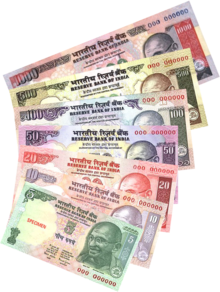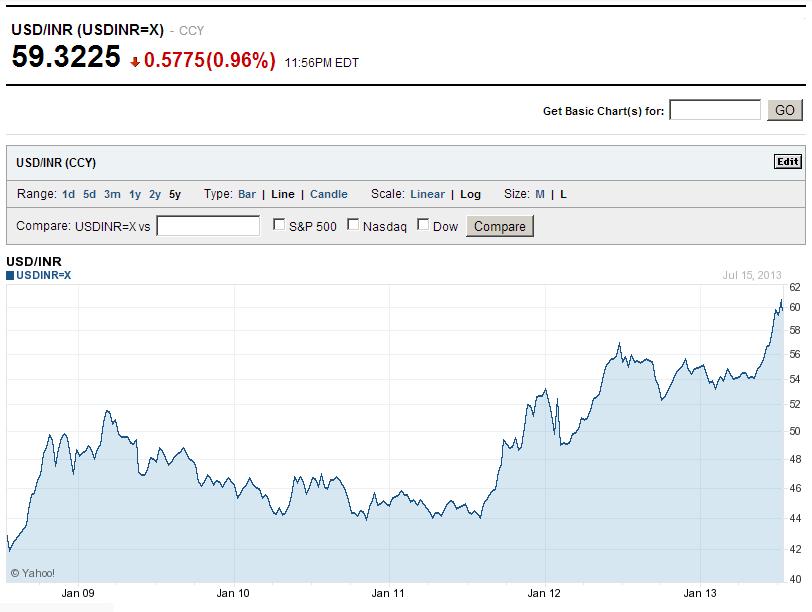Indian Central Bank Steps in to Save the Shun-Down Rupee
- India's central bank steps in to ease volatility in the rupee as markets crossed the 61 level against the USD. The RBI hikes interbank lending rates and sells government securities in a bid to stablise the currency.

Emerging market currencies have been on the back seat against the greenback as the world's largest economy is witnessing strong economic growth post global recession. Most emerging market currencies including the South African Rand and Indian Rupee have been suffering dramatic declines as both global factors such as commodities prices and internal factors such as inflation are ploying with their rates.
The Remedy
India's central bank has made an attempt to save the rupee as it increases interbank lending rates and offloads government bonds. The Reserve Bank of India raised lending rates to commercial banks by 2% to 10.25% making the loans more expensive. This was followed by the RBI's sale of government securities worth $2.5 billion (USD).
The rupee has been under fire after hitting record lows as inflation has been curbing the Indian economy. The recent Volatility Volatility In finance, volatility refers to the amount of change in the rate of a financial instrument, such as commodities, currencies, stocks, over a given time period. Essentially, volatility describes the nature of an instrument’s fluctuation; a highly volatile security equates to large fluctuations in price, and a low volatile security equates to timid fluctuations in price. Volatility is an important statistical indicator used by financial traders to assist them in developing trading systems. Traders In finance, volatility refers to the amount of change in the rate of a financial instrument, such as commodities, currencies, stocks, over a given time period. Essentially, volatility describes the nature of an instrument’s fluctuation; a highly volatile security equates to large fluctuations in price, and a low volatile security equates to timid fluctuations in price. Volatility is an important statistical indicator used by financial traders to assist them in developing trading systems. Traders Read this Term in precious metals has been another cause for concern for India’s financial watchdog in relation to it's currency as the Gold-INR-USD triangular arbitrage trade found momentum with the sharp declines in the yellow metal.
“Indians love to trade Gold and with the metal on a downhill move traders are playing the arb game” explained Amit Rathi, a Mumbai based trader in a comment to Forex Forex Foreign exchange or forex is the act of converting one nation’s currency into another nation’s currency (that possesses a different currency); for example, the converting of British Pounds into US Dollars, and vice versa. The exchange of currencies can be done over a physical counter, such as at a Bureau de Change, or over the internet via broker platforms, where currency speculation takes place, known as forex trading.The foreign exchange market, by its very nature, is the world’s largest tradi Foreign exchange or forex is the act of converting one nation’s currency into another nation’s currency (that possesses a different currency); for example, the converting of British Pounds into US Dollars, and vice versa. The exchange of currencies can be done over a physical counter, such as at a Bureau de Change, or over the internet via broker platforms, where currency speculation takes place, known as forex trading.The foreign exchange market, by its very nature, is the world’s largest tradi Read this Term Magnates.
USD INR
EMFX
Brokers in the FX and CFD markets have started diversifying their instrument offerings to allow traders access to emerging market currencies, a recent influx of brokers offering CFDs on emerging market currencies shows that volatility is still a key driver in the worlds most liquid asset class and the new offerings allow brokers to expand their product range to attract new clients.
Say no to speculation
Last week the central bank and securities market regulator, SEBI, banned banks from taking speculative trades in INR currency futures. In a statement by the RBI the central bank stated that banks: “Should not carry out any proprietary trading in the currency futures/exchange-traded currency options markets”. Banks were only able to trade on the behalf of clients.
In addition, the Securities and Exchange Board of India, the regulator that overlooks India’s equities and futures markets raised margin requirements for FX futures.
Increasing offshore volumes
The harsh movements in the Indian rupee have been favouring volumes in the offshore currency futures markets. Dubai based DGCX was the first overseas exchange to list the INR futures contract and has been witnessing record trade volumes in its benchmark INR/USD contract. A consistent theme at the CME who recently launched the contract, an un-named source from the exchange informed Forex Magnates that average daily trade volumes are picking up and have seen figures floating around the $200 million mark.
Emerging market currencies have been on the back seat against the greenback as the world's largest economy is witnessing strong economic growth post global recession. Most emerging market currencies including the South African Rand and Indian Rupee have been suffering dramatic declines as both global factors such as commodities prices and internal factors such as inflation are ploying with their rates.
The Remedy
India's central bank has made an attempt to save the rupee as it increases interbank lending rates and offloads government bonds. The Reserve Bank of India raised lending rates to commercial banks by 2% to 10.25% making the loans more expensive. This was followed by the RBI's sale of government securities worth $2.5 billion (USD).
The rupee has been under fire after hitting record lows as inflation has been curbing the Indian economy. The recent Volatility Volatility In finance, volatility refers to the amount of change in the rate of a financial instrument, such as commodities, currencies, stocks, over a given time period. Essentially, volatility describes the nature of an instrument’s fluctuation; a highly volatile security equates to large fluctuations in price, and a low volatile security equates to timid fluctuations in price. Volatility is an important statistical indicator used by financial traders to assist them in developing trading systems. Traders In finance, volatility refers to the amount of change in the rate of a financial instrument, such as commodities, currencies, stocks, over a given time period. Essentially, volatility describes the nature of an instrument’s fluctuation; a highly volatile security equates to large fluctuations in price, and a low volatile security equates to timid fluctuations in price. Volatility is an important statistical indicator used by financial traders to assist them in developing trading systems. Traders Read this Term in precious metals has been another cause for concern for India’s financial watchdog in relation to it's currency as the Gold-INR-USD triangular arbitrage trade found momentum with the sharp declines in the yellow metal.
“Indians love to trade Gold and with the metal on a downhill move traders are playing the arb game” explained Amit Rathi, a Mumbai based trader in a comment to Forex Forex Foreign exchange or forex is the act of converting one nation’s currency into another nation’s currency (that possesses a different currency); for example, the converting of British Pounds into US Dollars, and vice versa. The exchange of currencies can be done over a physical counter, such as at a Bureau de Change, or over the internet via broker platforms, where currency speculation takes place, known as forex trading.The foreign exchange market, by its very nature, is the world’s largest tradi Foreign exchange or forex is the act of converting one nation’s currency into another nation’s currency (that possesses a different currency); for example, the converting of British Pounds into US Dollars, and vice versa. The exchange of currencies can be done over a physical counter, such as at a Bureau de Change, or over the internet via broker platforms, where currency speculation takes place, known as forex trading.The foreign exchange market, by its very nature, is the world’s largest tradi Read this Term Magnates.
USD INR
EMFX
Brokers in the FX and CFD markets have started diversifying their instrument offerings to allow traders access to emerging market currencies, a recent influx of brokers offering CFDs on emerging market currencies shows that volatility is still a key driver in the worlds most liquid asset class and the new offerings allow brokers to expand their product range to attract new clients.
Say no to speculation
Last week the central bank and securities market regulator, SEBI, banned banks from taking speculative trades in INR currency futures. In a statement by the RBI the central bank stated that banks: “Should not carry out any proprietary trading in the currency futures/exchange-traded currency options markets”. Banks were only able to trade on the behalf of clients.
In addition, the Securities and Exchange Board of India, the regulator that overlooks India’s equities and futures markets raised margin requirements for FX futures.
Increasing offshore volumes
The harsh movements in the Indian rupee have been favouring volumes in the offshore currency futures markets. Dubai based DGCX was the first overseas exchange to list the INR futures contract and has been witnessing record trade volumes in its benchmark INR/USD contract. A consistent theme at the CME who recently launched the contract, an un-named source from the exchange informed Forex Magnates that average daily trade volumes are picking up and have seen figures floating around the $200 million mark.


